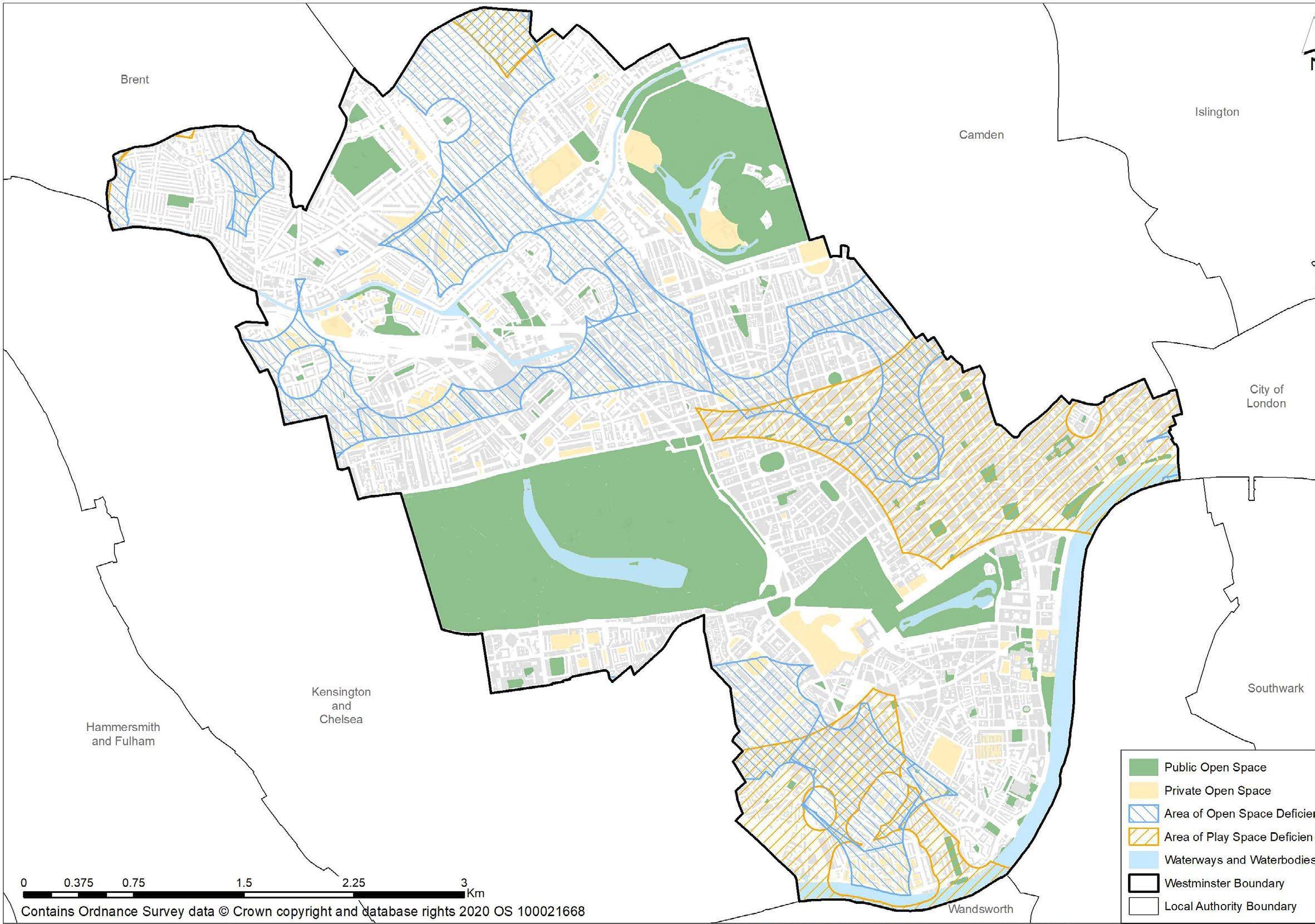4.8 Play and Recreation Space
Related SPD sections
• 4 3 Green infrastructure
• 4.6 Paving m aterials
• 4.13 Signs and adverts
• 4.5 Street Furniture
• 4.14 Public art, statues and m onuments
Key City Plan policies 34. Green infrastructure 43. Public realm
Context
Westminster has areas of high resident population density, while the quadrupling in its daytime population due to people commuting into the city to work creates significant additional demand for physical activity, leisure and/or sport provision.
In Westminster’s dense and busy urban environment, there are limited opportunities for children to roam, play and navigate the built environment freely. Urban environments can feel unsafe, inhospitable, and unwelcoming to children and young people. In addition, issues of childhood obesity, mental health problems, and physical health impacts from air pollution, have become increasingly common among young city dwellers. How places are built and designed is critical to creating more active and playful public streets and spaces.
Children and young people are essential public space users and play is a key aspect of their development, culture, and quality of life. The first years of a child’s life are particularly crucial to their development and the built environment can help support positive experiences through providing opportunities for play.
Whilst demand for play space is addressed through more discrete provision (playing pitches, built facilities and informal recreational facilities), there remains an identified overall lack of play facility provision in Westminster, with a shortage of facilities geared towards older children and young people. Some areas of the city, such as Church Street, Pimlico, Little Venice, East Marylebone, and Soho, have a deficiency in play and informal recreational facilities and a higher concentration of children compared to other parts of the city. See Figure 80 below

Figure 63: Open and Play Space Deficiency Areas across Westminster.
The Council is keen to take opportunities to add play and informal recreational facilities in such areas, whenever and however they arise, including opportunities such as ‘Play Street’ initiatives, as part of the council’s overall ‘Active Streets’ programme.
Child-friendly design goes beyond designing playground provision, and towards shaping the physical features around and in between buildings in neighbourhoods to become multifunctional, inclusive, and welcoming for everyone.
There is a wider role that the public realm can play to contribute to the expanding opportunities for more informal play and recreation. Local access to opportunities for play and recreation can contribute to the health and wellbeing of residents and visitors as it can encourage independent and active play, mobility, curiosity, discovery, entertainment, access to nature, human interaction, and social integration. Appropriate provision of opportunities for play and recreation can also make a positive contribution to reducing anti-social behaviour.
High quality streets, parks and spaces can encourage, facilitate, and enable physical activity by default. They can also help focus attention towards less traditional spaces often used by those not participating in physical activity, leisure, and sport.
London Plan Policy S4 sets out that large-scale public realm developments should incorporate incidental play space to make the space more playable.
City Plan policy 34 Green Infrastructure, Open Space D sets out that major developments will be required to provide new or improved public open space and space for children’s active play, particularly in areas of open space or play space deficiency.
WCC’s Planning Obligations and Affordable Housing SPD sets out that: When a requirement is triggered, s106 legal agreements will be used to secure on-site provision. Where it is not practical to deliver on-site, financial contributions may be accepted.
The Council's Play Facilities Strategy sets out best practice recommendations including:
• The quality of spaces and routes for children and young people should be assessed, alongside the quantum of space.
• Widened pavements and shared surfaces should be key considerations in street design to allow for the non-linear, meandering movement patterns of children.
• Safe routes should connect children and young people’s amenities through well-marked and playfully designed streets and public transport provision, including suitable lighting.
• Streets should be designed to reduce the speed of drivers in residential areas where possible.
‘Play street’ orders 67 are tools that can be used to achieve temporary street closures to allow children and young people to play on the street. See further guidance in relation to School Streets in Section 4.1 Highway Space, Road Safety and Parking.
Play and Recreation Space Guidance
A. Public realm interventions should contribute to providing further opportunities for people to enjoy play and leisure activities.
B. Where appropriate and in response to an identified need, dedicated play space and facilities should be provided.
C. Opportunities for playful design should be incorporated.
D. Public realm schemes should seek to improve access to existing local play and recreation opportunities through the provision of links and wayfinding
E. ‘Meanwhile’ proposals which expand opportunities for play and recreation will generally be supported, where these can be provided safely, and where there is demonstrated need.
F. Loss of publicly accessible play facilities by private developments will not be acceptable.
G. Proposals for play and recreation space should seek to ensure easy access to public conveniences or where relevant, improve access to existing facilities.
H. Seating and resting points should be provided through play and recreation spaces.
67 https://playingout.net/wp-content/uploads/2017/03/Legal-basis-for-Temporary-Play-Street-Orders-.pdf
